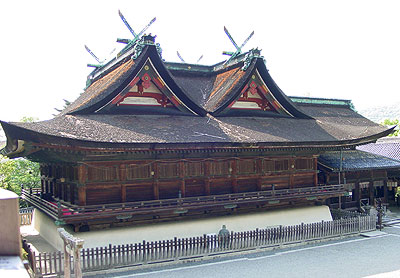|
||
 |
||

Kibitsu
Jinja 吉備津神社 (Okayama)
(C)2001 Japanese Architecture and Art Net Users System. No reproduction or republication without written permission.
掲載のテキスト・写真・イラストなど、全てのコンテンツの無断複製・転載を禁じます。
|
||||||
| kibitsu-zukuri 吉備津造 | ||||||
| KEY WORD : architecture / shrines | ||||||
| Also kibi-zukuri 吉備造 and *hiyoku
irimoya-zukuri 比翼入母屋造. A unique style of shrine architecture limited to
the main sanctuary *honden
本殿 and worship hall *haiden
拝殿 at Kibitsu Jinja 吉備津神社, in Okayama prefecture. The present honden is
dated 1425 according to an inscription found attached to the ridge. The older
honden was completely gutted in 1061, rebuilt, and destroyed again in 1351.
A strong influence from the daibutsu style *daibutsuyou
大仏様, established by the Buddhist priest,
Shunjoubou Chougen 俊乗坊重源 (1121-1206), is unmistakable.
Chougen donated a bell to the Kibitsu Jinja around the time of one of its reconstructions.
The plan, 14.64 m x 17.99 m, is extraordinarily large compared to the average
sized honden. While the Kibitsu Jinja is the same width as most shrines,
5 bays in front and 7 bays in the rear, it is eight bays deep on each side. However,
all bays are not of equal width but correspond to the depth of each division of
the interior. See plan. This unique style is easily identified by the unusual
variation the typical hip-and-gable roof *irimoya-zukuri
入母屋造. A roof called hiyoku irimoya-zukuri covers the honden. It
is characterized by additional ridges constructed at a right angle to the main
ridge allowing the creation of two false dormer gables *chidori
hafu 千鳥破風, on each side of the roof. Layers of cypress bark *hiwadabuki
桧皮葺 cover the roof. The honden sits on a very high tortoise belly foundation
*kamebara 亀腹, a mound of hard
packed earth and rubble covered with a thick layer of white plaster *shikkui
漆喰. Surrounding the honden is a shallow, railed veranda, marwari-en
回縁. The complex interior contains two sanctuaries. The innermost *nainaijin
内内陣, is 3 × 2 bays and resembles a common three bay space *sanja-zukuri
三社造. This is bordered on the front by a 3 x 1 bay inner sanctuary *naijin
内陣, which has three sets of descending steps: the first is in the front of the
nainaijin and extends the width equal of the central bay; the second and
third set of steps are on either end and are equal in width to the single bay
depth of the naijin. The two sanctuaries together can be equated with a
honden in ordinary shrines. At the bottom of the second set of steps is
a 1-bay deep × 5-bays wide *kouhai
向拝 (worship place). Surrounding the whole is the *chuujin
中陣. Parallel to the steps leading from the naijin to the chuujin
are stairs descending to an outer aisle *gejin
外陣. There are also stairs at the center front which lead down to the kouhai-no-ma
向拝の間, also called ake-no-dan 朱の壇, a 5 x 1 bay area a step above the gejin.
The entire area including the floor, pillars (these do not have bracket complexes,
and directly bear the weight of a huge beam), stairs, railings and doors are all
covered with vermillion lacquer tanshu-urushi 丹朱漆. Even the coffered ceiling
*goutenjou 格天井, is accented
with the same brilliant vermilion and a rich black lacquer. The tie beam *nuki
貫 is also painted black. The height of all ceilings rise in relation to the height
of each floor. The unusual outer sanctuary, gejin, completely surrounds
the above described inner sanctuary and is similar to the plan of a *jougyoudou
常行堂, a hall for circumambulation, found in certain temples of the Tendai 天台 sect.
The haiden, 1 x 3 bays, surrounded by a skirting pent roof *mokoshi
裳階 on three sides, is attached to one end of the honden. It is about eight
steps lower than the veranda surrounding the honden. The main roof is gabled
*kirizuma yane
切妻屋根, and like the honden is covered with layers of cypress bark. The pent
roofs of the mokoshi are tiled *kawarabuki
瓦葺. A main roof with pent roofs below is also called koshiyane 腰屋根. The
entire building, with single rafters extending to form deep eaves, is clearly
a conglomerate style with characteristics traceable to the *wayou
和様, daibutsuyou and *zenshuuyou
禅宗様. The following are the dominant characteristics of the wayou style:
bracket complexes *tokyou
斗きょう, placed directly on top of the pillars; a circular plate *sarato
皿斗, between the large bearing blocks *daito
大斗, and the top of the pillar; an uppermost bracket minus bearing blocks *sanehijiki
実肘木, directly supporting a beam; vertically latticed windows *renjimado
連子窓, and simple rainbow beams *kouryou
虹梁. The daibutsuyou and zenshuuyou have the following characteristics: a groove,
*shakujoubori 錫丈彫,
cut on the undersides of rainbow beams; bottle struts *taiheizuka
大瓶束, between the rainbow beams and ridge in the haiden; extended ends or
nosing *kibana 木鼻, carved with
cyma curves *shinogi 鎬;
and bracket arms inserted directly into the pillars. All these stylistic elements
are combined with exceedingly tall pillars, and exposed-rafter ceilings in the
haiden. These features combined with the overall enormity of the building
creates the unique kibitsu style. |
||||||
 Kibitsu
Jinja 吉備津神社 (Okayama)
|
||||||
| REFERENCES: | ||||||
| EXTERNAL LINKS: | ||||||
| NOTES: | ||||||
(C)2001 Japanese Architecture and Art Net Users System. No reproduction or republication without written permission. 掲載のテキスト・写真・イラストなど、全てのコンテンツの無断複製・転載を禁じます。 |
||||||